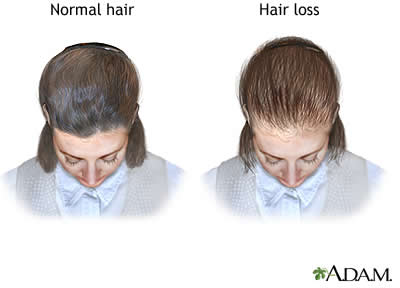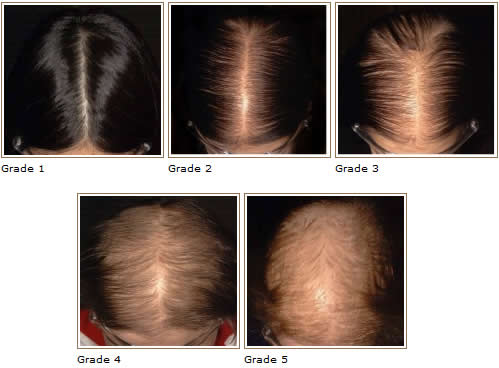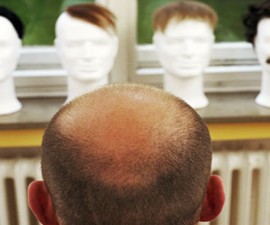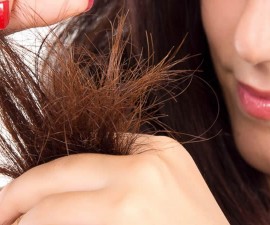Hair loss (alopecia) can be attributed by a number of different causes, from lifestyle factors to genetic trait (hereditary factor). The cause of the problem can also play a key role on the prognosis and outlook of whether or not the hair follicles will grow back normally.
Understanding the normal life cycle of your hair follicle
You are born with a ‘fixed’ number of hair follicles on your scalp. And this number can vary for each individual.
Each hair shaft grows from the base of hair follicle and will go with three main phases; growing (anagen), transition (catagen), and resting (telogen).
Growing phase can take years, and hair shaft will grow for about 1 cm (0.03 ft) for each month. Then it goes into catagen phase, when it starts to stop growing (typically it lasts about 2-3 weeks).
Naturally, there are usually only 3 percent of all hair follicles going into resting phase so thus you still have head full of hair.
After catagen phase, your hair follicle goes into telogen phase, when hair follicle is completely at rest. In the end of telogen phase, the old hair will fall out and then replaced by a new hair. And another anagen phase begins. This cycle continues throughout life!
In women, how do they know if their hair loss is hereditary?
Androgenetic alopecia in women is often called as female pattern hair loss or female pattern baldness. It is the most common form of hair loss in women.
How does a woman get androgenetic alopecia?
Female pattern baldness is a hereditary condition, in which it has a strong genetic predisposition. There may be many genes that can trigger this hereditary hair loss. And women could inherit these genes from either parent or both.
*Image credit to Adam
Androgenetic alopecia means hair loss that is linked to androgens (male sex hormones) and genetics. But in female pattern baldness, the effect of androgen is not as significant as in male pattern baldness. Even it’s still debatable whether androgens do have a role in female pattern baldness.
Another possible cause may come from aging and the decline of estrogen. In fact, it is commonly found in older women with pre-menopause or after menopause, when the level of estrogen declines drastically.
How do women know if their hair loss is hereditary?
It seems that the way of women going to bald is different than what we find in male pattern baldness.
In women with female pattern baldness, there is usually no distinct bald spot of hair loss since the problem is likely to cause thinning hair on the entire scalp. Many times, they also don’t experience receding hairline, a common early sign of male pattern.
However, the very thinning hair on the crown can become quite shinny when the problem has become advanced (see the following picture, credit to DermNet NZ). The progression occurs gradually and can take years.
Since it can take so long to progress (in years), it’s not always easy distinguish it from other kinds of hair loss. For instance, the symptoms of telogen effluvium can be similar to the early symptoms of female pattern baldness.
But for summary, below are major checklists of how thinning hair develops in most women with female pattern baldness:
- Typically, there is no skin sores or itching on the scalp.
- It is likely to begin with a widening through the center hair part.
- So although thinning hair can affect any hair follicles (the entire scalp), but it mainly occurs on the top and crown of the scalp.
- The front hairline is less likely to be affected. If this part is really affected, it may occur due to normal recession that can happen to anyone. Again in fact, receding hairline is not common in female pattern baldness.
- The good news, the problem is less likely to cause a complete baldness. Unlike the name suggests, baldness in women with female pattern baldness is quite rare.
In men, how to determine if their hair loss is hereditary?
Androgenetic alopecia in men is also often called as male pattern baldness or male pattern hair loss. And it is also the most common form of hair loss in men.
How do men get it?
The exact cause may still remain puzzling and is not fully understood yet. But experts have confirmed that it is an inherited condition.
Typically, men with this hair loss problem are genetically more sensitive to an androgen called dihydrotestosterone (DHT). In these men, it’s thought that DHT can contribute to shorten the growth of hair follicle (anagen phase).
As a result, the normal life cycle of hair follicle is affected. The duration of growing phase (anagen) that typically takes about 3-6 years can be shorter by up to months or even weeks. At the same time, this is followed with the progressively production of fewer and finer hair follicles.
How do men know if they have hereditary male pattern hair loss?
If you are a man with male pattern baldness, the problem usually starts at the front hairline, causing receding hairline. The front hairline will gradually recede (move backward) and eventually may cause M-shape.
In some cases, thinning hair on the crown may start first. It then may be followed by receding hairline. Or both receding hairline and thinning hair on the crown occur together at the same time.
Overtime, the problem may get worse if left untreated, causing horseshoe (U-shape) – see the following picture!







Am priya,
i was loosing my hair from past 5 years consulted many doctors no use.No heatlh issues no heredity .can anyone please help me .
Hi Priya,
Have you ever tried hair medicine?
I suggest trying to use candlenut